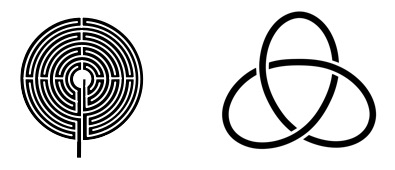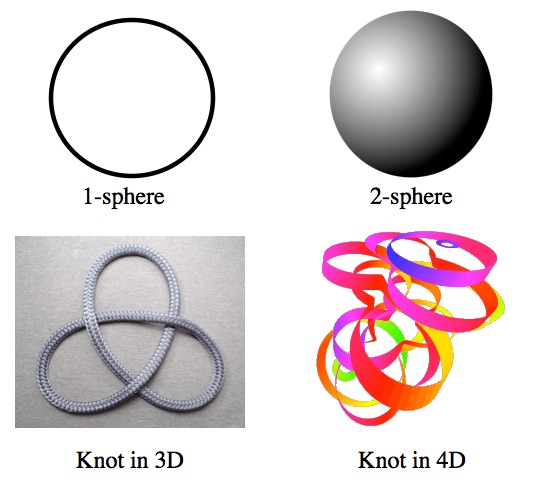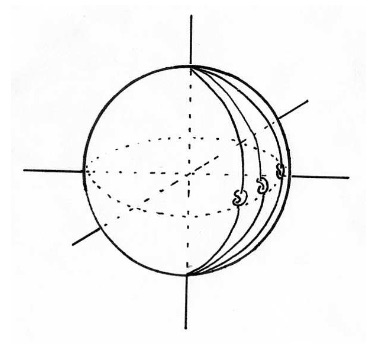Physicist: Yes!

Just to be clear, we’re not talking about this. This is cheating.
Mathematicians are pretty good at talking about things in spaces with any number of dimensions. Sometimes that math is fairly easy and even intuitive. For example, a line has 2 sides (ends), a square has 4 sides, a cube has 6 sides, and a hypercube has __* sides.
Ordinary knots (that you can tie with string) can only exist in exactly 3 dimensions. It’s impossible to create a knot in 2D since every knot involves some amount of “over-and-under-ing” and in 2D space there’s none of that. Because it makes the math more robust, mathematicians always talk about knots being tied in closed loops rather than on a bight. In part because once you’ve connected the ends of your string the knot you’ve got is the knot you’ve got, and that invariance is very attractive to math folk.

Left: In two dimensions, no matter how complicated and convoluted your string is it can never be tied in a knot. Right: Even the simplest knot requires at least three over-under excursions into three dimensional space to get around self-intersections.
In 2D, if you have a dot inside of a circle, it’s stuck. But if you have access to another dimension (“dimension” basically means “direction”), then you can get the dot out. In exactly the same way, if you can “lift” part of a regular knot into a fourth dimension it’s like opening the loop and you’re free to untie your knot in the same way you’d untangle/untie anything. Afterwards you just “lower” the segment of the string back so that it all sits in 3D and now you’ve just got a loop of unknotted string (very creatively, this is called an “unknot”). So, you’ve managed to untied your knot without worrying about self-intersections and all it took was an extra dimension.

In 2D a dot can be stuck inside of a circle, but if we have the option to “lift” part of the circle in a new direction then the dot can get out. From the perspective of the flat denizens of 2D space, this looks like part of the circle being removed.
All that was just to say: be excited, the way you tie your shoes is only possible in universes similar to (with the same number of dimensions as) our own. You can’t tie a knot in a string in two dimensions and a knotted string in four (or more) isn’t really knotted at all.
The way we talk about ordinary knots is in the context of a loop (tie your knot and then splice the loose ends of the string). The generalization of a loop (a 1-sphere) to higher dimensions is first the surface of a regular sphere (a 2-sphere), then the surface of a hyper-sphere (a 3-sphere) and so on. An N-sphere can be tied in a knot in N+2 dimensional space.

An N-sphere can be tied in knots in N+2 dimensions. 1-spheres can be tied in knots in three dimensions (these are known colloquially as “knots”), which means that they can actually be created. 2-spheres (the surface of a ball) can be tied in knots in four dimensions. The image here is only a cross-section of such a knot.
It turns out that if you have an ordinary knot, you can use it to create a higher dimensional knot. There are a several ways to do this. There’s “suspension“, which usually doesn’t work (the created knot is often not a “manifold“, which is kinda cheating), and there’s also “spinning” which always works.

The basic idea behind spun knots.
To create a “spun knot” you rotate it in a higher dimensional space and collect all of the points that it sweeps through. The picture above is more symbolic than applicable. In this picture a knot in 3D is spun to create a sphere that’s still in 3D space, but with a funky-shaped tube running around its equator. That’s not a knot (knot at all). This process needs to be done in four dimensions, where the added direction allows you to get around the self-intersection problem, but the basic idea is the same. So for every knot that you can tie with a loop of rope in 3D, there’s a knot you can tie with a hollow sphere in 4D.
And yes: you can keep going into higher and higher dimensions using the same idea.
While you can’t directly picture a four dimensional knot, you can create cross-sections (the same way a 2-dimensional being might picture 3-dimensional objects using cross-sections). This video (~0.4MB) shows 3D cross-sections of a rotating 4D knot. But be warned: that video is, for lack of a better word, groovy.
Sometimes a group of scientists will get really involved with a particular subject and kinda disappear up their collective butts for a while (especially mathematicians). Eventually one of them will emerge like a prairie dog and bark “fellow dudes and dudesses, we should really send a message to the world so they don’t worry about us” at which point a summarizing paper such as this or this is written (about higher dimensional knots in this case), in an attempt to convey to a slightly broader audience what they’ve been doing.

Mathematicians after a long think.
The tied sheets painting is by Teun Hocks and is from here.
The 4D knot picture and the video are from here.
The spun knot picture was lifted remorselessly from the second paper mentioned earlier.
*8







10 Responses to Q: Can planes (sheets) be tied in knots in higher dimensions the way lines (strings) can be tied in knots in 3 dimensions?